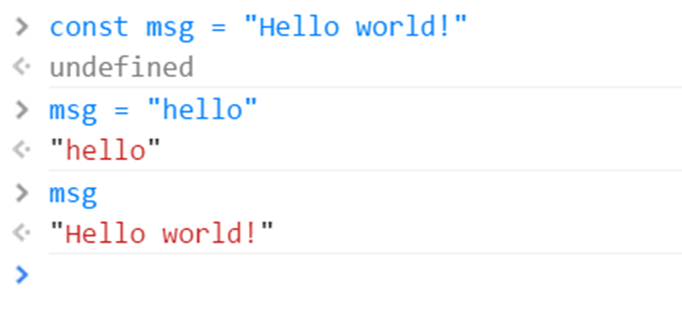基础变化
- String类型新增了三个方法,不必使用indexOf来判断一个字符串是否在另一个字符串内
//String changes var a = "Hello world"; var b = "Hello"; var c = "world"; function includes(source, dest) { return source.indexOf(dest) > -1; } function startsWith(source, dest) { return source.slice(0, dest.length) === dest; } function endsWith(source, dest) { return source.slice(source.length - dest.length, source.length) === dest; } var msg = "Hello world!"; console.log("msg startsWith Hello: ", msg.startsWith("Hello")); // true console.log("msg endsWith !: ", msg.endsWith("!")); // true console.log("msg includes o: ", msg.includes("o")); // true console.log("msg startsWith o: ", msg.startsWith("o")); // false console.log("msg endsWith world!: ", msg.endsWith("world!")); // true console.log("msg includes x: ", msg.includes("x")); // false
- Object.is方法用来判断两个参数是否相等,与全等(===)类似只是在+0和-0上以及NaN与NaN的判断上与全等不同
console.log(+0 == -0); // true console.log(+0 === -0); // true console.log(Object.is(+0, -0)); // false console.log(NaN == NaN); // false console.log(NaN === NaN); // false console.log(Object.is(NaN, NaN)); // true console.log(5 == 5); // true console.log(5 == "5"); // true console.log(5 === 5); // true console.log(5 === "5"); // false console.log(Object.is(5, 5)); // true console.log(Object.is(5, "5")); // false
- let声明,let与var的作用相同,只是以let声明的变量的作用域在当前的{}块内
function getValue(condition) { if (condition) { let value = "blue"; // other code return value; } else { // value doesn't exist here return null; } // value doesn't exist here }
- const关键字用来声明常量,常量一旦赋值就无法改变,其他的赋值表达式都会被忽略

- 解构赋值,引入解构赋值可以方便的从复杂的对象中取得所需的属性值
var options = { repeat: true, save: false, rules: { custom: 10, } }; // later var { repeat, save, rules: { custom }} = options; console.log(repeat); // true console.log(save); // false console.log(custom); // 10
类
- 类声明语法,目前许多前端框架比如dojo、extJs使用辅助设计使得Javascript看起来支持“类”,基于以上目的ES6引入类体系;目前在Chrome使用class关键字必须使用严格模式
//class declaration function PersonType(name) { this.name = name; } PersonType.prototype.sayName = function() { console.log(this.name); }; let person = new PersonType("Nicholas"); person.sayName(); // outputs "Nicholas" console.log(person instanceof PersonType); // true console.log(person instanceof Object); // true (function(){ 'use strict'; class PersonClass { constructor(name) { this.name = name; } sayName() { console.log(this.name); } } let person = new PersonClass("Nicholas"); person.sayName(); // outputs "Nicholas" console.log(person instanceof PersonClass); console.log(person instanceof Object); })()
- 属性访问器,通过使用get和set关键字来声明属性(Attribute),在ES5中需要借助Object.defineProperty来声明属性访问器
//Accessor Properties (function(){ 'use strict'; class PersonClass { constructor(name) { this.name = name; } get Name(){ return this.name; } set Name(value){ this.name = value; } } let person = new PersonClass("Nicholas"); console.log('person.Name: ', person.Name) // outputs "Nicholas" })()
- 静态成员,ES5或者之前的代码通过在构造函数中直接定义属性来模拟静态成员;ES6则只需要在方法名前面加上static关键字
//ES5 function PersonType(name) { this.name = name; } // static method PersonType.create = function(name) { return new PersonType(name); }; // instance method PersonType.prototype.sayName = function() { console.log(this.name); }; var person = PersonType.create("Nicholas"); //ES6 //Static Members (function(){ 'use strict'; class PersonClass { constructor(name) { this.name = name; } sayName() { console.log(this.name); } static create(name) { return new PersonClass(name); } } let person = PersonClass.create("Nicholas"); console.log(person); })()
- 继承,ES5中需要借助prototype属性而ES6中引入extends关键字来实现继承
//Handling Inheritance (function(){ 'use strict'; class PersonClass { constructor(name) { this.name = name; } } class Developer extends PersonClass { constructor(name, lang) { super(name); this.language = lang; } } var developer = new Developer('coder', 'Javascript'); console.log("developer.name: ", developer.name); console.log("developer.language: ", developer.language); })()
模块机制
当前关于JS的模块化已有两个重要的规范CommonJs和AMD,但毕竟不是原生的模块化,所以ES6中引入模块化机制,使用export和import来声明暴露的变量和引入需要使用的变量

Iterator和Generator
Iterator拥有一个next方法,该方法返回一个对象,该对象拥有value属性代表此次next函数的值、done属性表示是否拥有继续拥有可返回的值;done为true时代表没有多余的值可以返回此时value为undefined;Generator函数使用特殊的声明方式,generator函数返回一个iterator对象,在generator函数内部的yield关键字声明了next方法的值
//Iterator & Generator // generator function *createIterator() { yield 1; yield 2; yield 3; } // generators are called like regular functions but return an iterator var iterator = createIterator(); console.log(iterator.next()); console.log(iterator.next()); console.log(iterator.next()); console.log(iterator.next());
Promise
ES6引入原生的Promise对象,Promise构造函数接受一个方法作为参数,该方法中可以调用resolve和reject方法,分别进入fulfill状态和fail状态
// Promise var getJSON = function(url) { var promise = new Promise(function(resolve, reject){ var client = new XMLHttpRequest(); client.open("GET", url); client.onreadystatechange = handler; client.send(); function handler() { if (this.readyState !== 4) { return; } if (this.status === 200) { debugger; resolve(this.responseText); } else { reject(new Error(this.statusText)); } }; }); return promise; }; getJSON("https://gis.lmi.is/arcgis/rest/services/GP_service/geocode_thjonusta_single/GeocodeServer?f=json").then(function(json) { console.log('Contents: ' + json); }, function(error) { console.error('Error: ', error); });
Proxy
顾名思义用来作为一个对象或函数的代理。Proxy构造函数接受两个参数:target用来被封装的对象或函数、handler拥有一系列方法,重写这些方法以便当调用这些操作时会进入重写的方法中
•handler.getPrototypeOf
•handler.setPrototypeOf
•handler.isExtensible
•handler.preventExtensions
•handler.getOwnPropertyDescriptor
•handler.defineProperty
•handler.has
•handler.get
•handler.set
•handler.deleteProperty
•handler.enumerate
•handler.ownKeys
•handler.apply
•handler.construct
handler.getPrototypeOf
handler.setPrototypeOf
handler.isExtensible
handler.preventExtensions
handler.getOwnPropertyDescriptor
handler.defineProperty
handler.has
handler.get
handler.set
handler.deleteProperty
handler.enumerate
handler.ownKeys
handler.apply
handler.construct
参考资料: